Alan M. Petrillo
The trend toward multifunctional apparatus can be most visibly seen in the rescue-pumper configuration, which has been embraced by city, suburban, and rural fire departments. However, manufacturers still see a strong need and desire for traditional heavy rescue trucks-both walk-in and walk-around models-that can carry all of a department’s rescue-related equipment on a single chassis.
Combination Bodies
Bill Proft, senior chief engineer and market manager of rescue products for Pierce Manufacturing Inc., says the multipurpose trend has hit traditional rescue trucks, where some fire departments are opting for combination-type bodies because they might be working with a reduced budget. “In the mid to late 1980s, before we had big, fully enclosed cabs on custom chassis, we didn’t have a lot of opportunity to fit firefighters into the cab, so rescue bodies tended to be the walk-in style, where the center section of the body could carry six or eight firefighters,” Proft says. “In the early 1990s, fully enclosed cabs came along where you could fit up to 10 firefighters, so rescue bodies were used more for storage and the pendulum swung over to walk-around rescue trucks.”
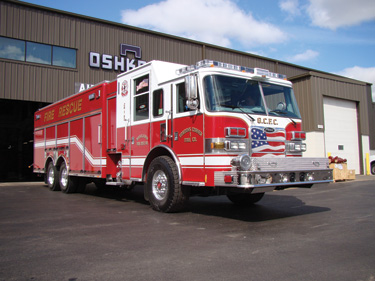 |
| (1) The Gordons Corners (NJ) Fire Co. No. 1., of the Manalapan (NJ) Fire District No. 1, turned to Pierce Manufacturing for this walk- around rescue with a crew cab walk-in area behind the driver’s compartment. (Photo courtesy of Pierce Manufacturing Inc.) |
The typical walk-around rescue truck has all exterior compartments on both sides of the body, Proft notes, and usually rooftop storage too, essentially making the vehicle a tool carrier.
In today’s world, both styles are still popular, Proft points out. “But, we’re seeing a lot more combination-style bodies where either the front or rear half of the truck is made a walk-in for carrying or rehabbing firefighters, and the other half a walk-around with lots of storage space for equipment,” he says. “
More with One
Ed Smith, director of sales and marketing for VT Hackney, agrees that fire departments today are trying to do more with a single piece of apparatus. “Manpower is a concern to some of them, particularly volunteer departments that at one time would fill up a pumper, a ladder, and a rescue and send them out the door one after the other,” Smith says. “They can’t do that anymore because volunteerism is becoming a thing of the past and they often have to take one truck to the call and make do with it, instead of three pieces of apparatus.”
Hackney’s strength in the market has always been building heavy rescue units, Smith maintains, where the rigs carry a full complement of ground ladders, shoring panels and timbers, an array of hydraulic tools, hand tools, and specialty rescue equipment. “Most of what we build are walk-around rescue trucks,” Smith says. “Walk-ins are a small portion of our numbers, perhaps because they take away storage capacity, which can be critical to some departments.”
 |
| (2) VT Hackney built this combination rescue and EMS vehicle for the Otsego County (MI) Fire Department. The unit carries Hackney’s proprietary automatic deploying roof staircase. (Photo courtesy of VT Hackney.) |
Hackney’s typical heavy rescue truck runs between 32 and 36 feet long, Smith points out, and the types are evenly split on custom and commercial chassis. “The focus seems to be on safety right now, where people are taking second looks at roof access ladders,” Smith says. “A popular option for us is our exclusive automatic deploy staircase that doesn’t take any space away on the vehicle. When it’s stowed, it is in the area on top of the truck where you would typically walk, and when it is deployed, that space is clear.”
Walk-Arounds and Water
Andy Yenser, rescue truck product manager for KME, says his company has been building more walk-around rescues than walk-ins, although there was a small upswing in walk-ins for KME last year. “It’s a very cyclical market much like the side-mount pumper vs. top-mount pumper,” Yenser says. “When a department is getting rid of a 20- to 30-year-old walk-in rescue, they tend to buy another walk-in.”
Many of the walk-around rescues KME has built are light- to medium-duty rigs on both custom and commercial chassis, although some departments have opted for heavy-duty rescues, Yenser notes. And, he says he’s also seen an upswing in rescue trucks carrying water. “For what we call a ‘wet rescue,’ which also could be called a rescue-pumper, we’ll put from a 250- to 2,000-gallon-per-minute (gpm) pump on it, and a water tank from 200 to 1,000 gallons,” Yenser says. KME builds its wet rescues on all of its chassis lines-Panther, Severe Service, and Predator.
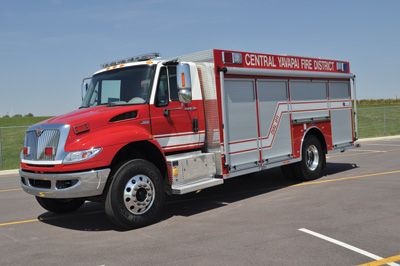 |
| (3) The Central Yavapai Fire District, in Prescott Valley, Arizona, went to Rosenbauer for this walk-around medium-duty rescue built on an International DuraStar chassis. (Photo courtesy of Rosenbauer.) |
Pierce also builds rescue-pumpers, particularly a model it calls the rescue Pierce Ultimate Configuration (PUC), Proft points out. “The PUC pump is tucked up under the cab between the frame rails to minimize the space it uses,” he says, which allows the space taken up by a typical pump and its plumbing to be used for compartmentation. Rescue PUC models carry up to 500-gallon water tanks and typically 1,500-gpm pumps, along with fire suppression tools and a full complement of rescue equipment.
All or Nothing
Donley Frederickson, national sales manager for Rosenbauer, says recently the rescue market has been in an “all-or-nothing mode, where it’s either a straightforward small rescue equipment hauler or a large heavy rescue where they put everything they can on it-cascade systems, fill stations, air compressors, and all their rescue equipment.”
Frederickson notes that most of the rescues Rosenbauer is building have pull-out, drop-down, and roll-out trays and tool boards to maximize compartment space. “We also have built rescue trucks where we have put hydraulic rescue tools at each of the four corners of the vehicle,” Frederickson says.
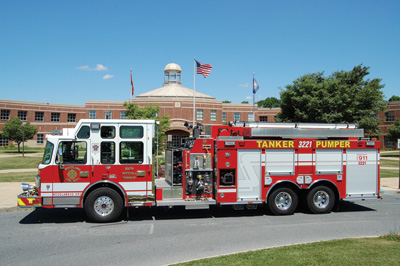 |
| (4) Woodlawn Fire Company, in Allentown, Pennsylvania, had Smeal Fire Apparatus build this combination rescue-pumper-tanker to serve a multipurpose role in the department. (Photo courtesy of Smeal Fire Apparatus.) |
Only one-third of the rescues Rosenbauer builds are walk-ins. The balance are walk-around rescues and rescue pumpers. “We’re seeing a lot more of the smaller equipment haulers going out right now,” Frederickson says, “everything from a Ford F-550 chassis rescue to the medium-duty International 7400 or Freightliner M2 chassis. There’s a trend toward smaller rescues, and I think the economy might be driving much of that right now. We don’t see the million-dollar rescue trucks much.”
Air Systems
Mike Marquis, vice president of sales for Rescue 1, says many fire departments want breathing air systems on board their rescue trucks that can be set up to fill air bottles on the scene when necessary. “Some departments also want to have an on-board foam system,” Marquis says. “We recently put a CAFS with a 120-gallon water tank and a 35-gallon foam cell on a rescue truck that will be able to disburse 2,400 gallons of foam on the scene.” Marquis notes the addition of the foam capability for that department was designed to fight car fires and for use during auto extrications. The unit can flow either foam or plain water.
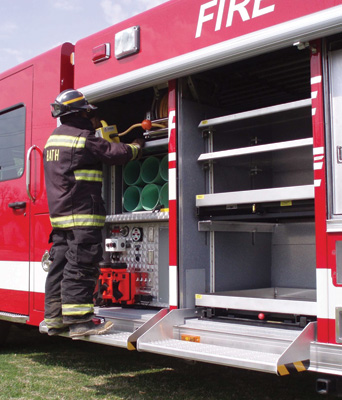 |
| (5) VT Hackney offers a fold-down step option underneath side compartments on its rescue trucks to allow safer and easier access to the rear sections of compartments. (Photo courtesy of VT Hackney.) |
The majority of the rescue trucks that Rescue 1 builds these days include some kind of breathing air system, Marquis says, as well as light towers, PTO-driven generators, oil-dry hoppers, and plenty of scene lighting. “We’re also seeing more drop-down access steps in compartments,” Marquis points out. “Departments are trying to use all the storage space in the body and if they use an access step, they can reach items farther back in a compartment.”
“We’re also seeing some PTO-driven compressors running up to 200 cubic feet per minute (cfm) on some trucks, where the customer is trying to get a little bit of urban search and rescue (USAR) use out of its truck, driving jackhammers and large air tools,” says Yenser.
Rescue-Pumper Innovations
Jeff Wegner, regional sales director of Smeal Fire Apparatus, says his company was building rescue-pumper configurations for years before they began to be called rescue-pumpers. “Our Freedom series is the product line for rescue-pumpers, which carries a 1,000-gallon water tank, a reduced-size pump panel, pumps from 750 to 2,250 gpm, and has full-depth compartments,” Wegner says. “CAFS is available on these models, and we offer them in both short and long body versions.” Wegner adds that many of the rescue-pumpers Smeal builds carry light towers, and most are outfitted with 12-volt high-intensity LED lighting.
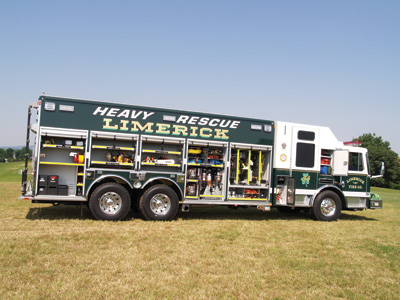 |
| (6) KME built this rescue-pumper with a 2,000-gpm pump and plenty of walk-around storage space for the Limerick (PA) Fire Company. (Photo courtesy of KME.) |
Wegner says Smeal has noticed a recent trend in the Northeast of building what he called a rescue-pumper-tanker. “Some departments are going with a 2,500- or 3,000-gallon tanker with a pump and full-depth compartments for their rescue equipment,” he says. “We’re building more of these every year.” Wegner thinks the trend toward a triple type of vehicle (rescue-pumper-tanker) “is probably because of shrinking budgets, and departments having to do more with a single vehicle.”
ALAN M. PETRILLO is a Tucson, Arizona-based freelance writer and is a member of the Fire Apparatus & Emergency Equipment editorial advisory board. He served 22 years with the Verdoy (NY) Fire Department, including in the position of chief.

